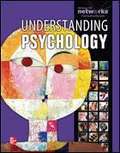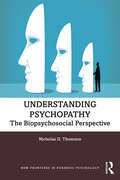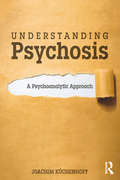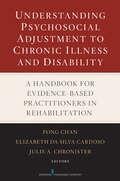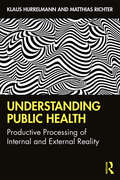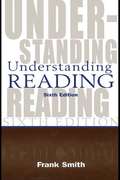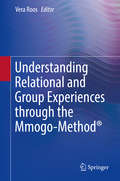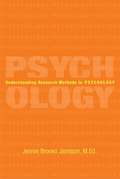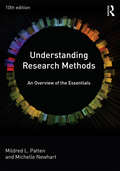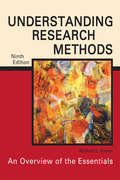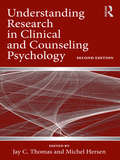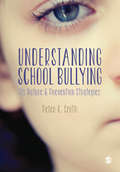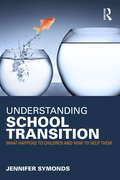- Table View
- List View
Understanding Psychology, Student Edition (Understanding Psychology Series)
by Richard A. KasschauConnect complex psychological concepts to real life Understanding Psychology simplifies complex psychological concepts for students. The program's philosophy is to make psychology relevant, fun, interesting, and approachable. Understanding Psychology is an interactive book with hands-on activities, case studies, current issues, and readings about the field of psychology.
Understanding Psychopathy: The Biopsychosocial Perspective (New Frontiers in Forensic Psychology)
by Nicholas D. ThomsonUnderstanding Psychopathy is an essential, accessible new guide on psychopathy and its development. Through the lens of the biopsychosocial model, Thomson explores a wide range of factors contributing to the development of psychopathy, from the genetic to the environmental, supported by the latest research into the disorder. Thomson examines psychopathy from all angles, analysing social, psychological and biological factors, in addition to the history and assessment of psychopathy, and links to violent crime. Theory and research are supported throughout with fascinating case studies. These case studies provide accessible and relevant examples for readers who are new to the field, and to those more familiar with psychopathy and its implications. Understanding Psychopathy is a brilliant resource for psychology students, researchers and practitioners in the criminal justice system alike, with grounding in forensic psychology, clinical psychology and criminology. The author is donating his royalties in full to Project EMPOWER, UK, a multidisciplinary initiative dedicated to enhancing prevention and intervention services to individuals and their families who experience intimate partner violence, sexual violence, domestic violence, or human trafficking.
Understanding Psychosis: A Psychoanalytic Approach
by Joachim KüchenhoffDo psychotic disorders make sense? Are psychotic symptoms amenable to interpretation? Understanding Psychosis: A Psychoanalytic Approach takes the various pathways to psychotic illness outlined by psychoanalytic clinicians and scholars and integrates them into a model that allows a systematic assessment of relevant psychodynamic dimensions in the diagnosis of psychotic disorders, and which serves as a guide to psychotherapy with psychotically ill patients. Joachim Küchenhoff reviews and integrates various psychoanalytic concepts and theories about psychosis into a multi-dimensional psychodynamic model that allows an assessment and understanding of the patient’s subjective experience, objective psychological capabilities, and interpersonal resources. Küchenhoff helps the therapist to establish a basic attitude in working psychodynamically with patients and to understand the dynamics of the therapeutic relationship. Understanding Psychosis also addresses specific issues that can arise in work with clients experiencing psychosis, including understanding imminent crises or precursor states, elucidating semiotic qualities in seemingly negative symptoms, differentiating the psychotic and a non-psychotic part of the personality and providing a dynamic approach to the psychopharmacological treatment. Clinical vignettes and three detailed case reports are included in the book. Understanding Psychosis will be an essential guide for psychiatrists, psychotherapists and psychoanalysts working with patients experiencing psychosis. It will also be of use to psychologists, and academics and students of psychotherapy, psychiatry and psychoanalysis for psychosis.
Understanding Psychosocial Adjustment to Chronic Illness and Disability
by Fong Chan Julie A. Chronister Elizabeth Da Silva CardosoRehabilitation practitioners face the difficult task of helping clients adjust to chronic illness or disability. This can be a long and trying process for both practitioner and client. With this handbook, however, practitioners and students can gain a wealth of insight into the critical issues clients face daily. <P><P> This book presents the dominant theories, models, and evidence-based techniques necessary to help the psychosocial adjustment of chronically ill or disabled persons. Each chapter is written from an evidence-based practice (EBP) perspective, and explores how important issues (i.e., social stigma, social support, sexuality, family, depression, and substance abuse) affect persons adjusting to chronic illness and disability. <P><P> Key features include: <BR> A review of psychopharmacological treatment options for depression, anxiety, and other disorders coinciding with rehabilitation <BR> The effect of rehabilitation on the family, including key family intervention strategies <BR> Strategies for using positive psychology and motivational interviewing in rehabilitation <BR> Multiculturalism and the effect of culture on the adjustment process <P><P> Ancillary materials including an instructor's manual with a syllabus, examination items, PowerPoint presentation, and answers to class exercises. By incorporating research-based knowledge into clinical rehabilitation practice, health care professionals can ensure that people with chronic illness and disability receive only the best treatment.
Understanding Public Health: Productive Processing of Internal and External Reality
by Matthias Richter Klaus HurrelmannThis book develops a new model of the genesis of health, on the basis of the interplay between genetic and environmental factors. Hurrelmann and Richter build upon the basic theories of health and the popular model of salutogenesis to offer a comprehensive interdisciplinary theory of health genesis and success: Productive Processing of Reality (PPR). The authors show that health is the lifelong dynamic process of dealing with the internal reality of physical and psychological impulses and the external reality of social and material impulses. To demonstrate this, the book is split into three interconnected parts. Part A analyses the determinants of health, providing an overview of the insights of current research and the impact of socioeconomic influences and gender on health. Part B covers public health, social, learning and coping theories, all of which understand health as an interaction between people and their environment. Part C draws on these four theories to outline PPR, stressing the interrelation between physical and mental constitution and the demands of the social and mental environment, and suggesting strategies for coping with these demands during the life course. Understanding Public Health: Productive Processing of Internal and External Reality will be valuable reading for students and researchers in psychology, sociology, educational science, public health and medical science, and for policymakers in public health.
Understanding Reading: A Psycholinguistic Analysis of Reading and Learning to Read
by Frank SmithUnderstanding Reading revolutionized reading research and theory when the first edition appeared in 1971 and continues to be a leader in the field. In the sixth edition of this classic text, Smith's purpose remains the same: to shed light on fundamental aspects of the complex human act of reading--linguistic, physiological, psychological, and social--and on what is involved in learning to read. The text critically examines current theories, instructional practices, and controversies, covering a wide range of disciplines but always remaining accessible to students and classroom teachers. Careful attention is given to the ideological clash that continues between whole language and direct instruction and currently permeates every aspect of theory and research into reading and reading instruction. To aid readers in making up their own minds, each chapter concludes with a brief statement of "Issues." Understanding Reading: A Psycholinguistic Analysis of Reading and Learning to Read, Sixth Edition is designed to serve as a handbook for language arts teachers, a college text for basic courses on the psychology of reading, a guide to relevant research on reading, and an introduction to reading as an aspect of thinking and learning. It is matchless in integrating a wide range of topics relative to reading while, at the same time, being highly readable and user-friendly for instructors, students, and practitioners.
Understanding Relational and Group Experiences through the Mmogo-Method®
by Vera RoosThis volume describes the development and application of the Mmogo-method® as a projective visual data gathering method, applied in different contexts and with different groups of people. The Mmogo-method® provides a more profound understanding of personal, relational and group experiences. "Mmogo" means togetherness in Setswana, one of the 11 official languages of South Africa. The Mmogo-method® is particularly useful in cross-cultural contexts and across age groups, and by allowing visual expressions of the self as a complex, dynamic social system it overcomes some of the limitations of traditional data collection methods, such as questionnaires or interviews. These chapters show how this flexible, visual data collection method can be used independently or jointly with other data gathering techniques, such as journalling or in-depth interviewing, to acquire rich information. The research method described in this book enables researchers to access perceptions, feelings and personal experiences participants might find it difficult to verbalize and explain. Researchers in disciplines such as education, social sciences, consumer sciences, market research, and city and town planning will find this book and its innovative method particularly valuable in addressing a gap in available visual and other data collection resources.
Understanding Religion and Spirituality in Clinical Practice (The Society of Analytical Psychology Monograph Series)
by Margaret ClarkUnderstanding Religion and Spirituality in Clinical Practice is a volume in the clinical practice monograph series from the Society of Analytical Psychology. This series is intended primarily for trainees on psychotherapy and psychodynamic counselling courses, and for those who are newly qualified. Here, the author considers the difficulties clinicians may encounter when patients talk about God or about their spiritual life, and how necessary it is for therapists to examine their own image of God and their own understanding of spirituality, so that they can distinguish these from those of their patients. She emphasizes how varied are people's images and understanding of what "God" stands for, and how in healthy development these will change over time. The book demonstrates, through numerous clinical vignettes, how clinicians can understand a patient's talking about religion or about God - hearing the voice of God, having a vision of God, or being convinced that God wants them to act in a particular way; or, equally, seeing the Devil.
Understanding Research Methods and Statistics in Psychology
by Helen GavinUnderstanding and applying research methods and statistics in psychology is one of the corner stones of study at undergraduate level. To enable all undergraduate psychology students to carry out their own investigations the textbook covers basic and advanced qualitative and quantitative methods and follows a sequential structure starting from first principles to more advanced techniques. Accompanied by a companion website, the textbook: - Grounds all techniques to psychological theory relating each topic under discussion to well established pieces of research - Can be used by the student at beginning and more advanced undergraduate level - therefore a `one-stop' shop - Includes a creative and practical selection of heuristic devices that cement knowledge of the techniques and skills covered in the textbook
Understanding Research Methods in Psychology
by Jennie Brooks JamisonThis book has three purposes. One purpose is to help students see that there are many options available to researchers for investigating behavior and that each method has a specific goal. The second purpose is to introduce students to qualitative research methods: interviewing, observation, and case studies. International Baccalaureate (IB) students taking the Higher Level (HL) course sit for Paper 3, a section of the exam about qualitative research. I weave headings throughout the chapters on qualitative research that correspond to Paper 3 learning outcomes. These IB learning outcomes are relevant for any psychology student. The third purpose is to teach students how to design a simple experiment and analyze the data. Students taking the International Baccalaureate and/or Advanced Placement exams in psychology will find what they need in this book. Research methods are probably the most difficult part of these exams. Introductory texts do not usually provide enough depth, while the typical college-level research methods books are too complicated, sometimes even for a college student's first experience with methodology.
Understanding Research Methods: An Overview of the Essentials
by Mildred L. Patten Michelle NewhartIn the eleventh edition of Understanding Research Methods: An Overview of the Essentials, Newhart and Patten leverage the principles of learning and content design to present the fundamentals students need to get started in research. Basics of quantitative and qualitative research are covered in short, independent topics and grouped into meaningful sections. A perennial bestseller for over ten editions, Understanding Research Methods focuses concisely on key concepts, and lessons in topics that are "chunked" to suit today’s students. Each topic ends with suggestions for planning a research project by answering topic-specific prompts in a research planning journal. Topic Review exercises encourage active learning. Finally, Topics for Discussion suggest open-ended prompts that could serve as conversation starters in the classroom or online. The final Part of the book offers guidance and activities specific to writing a research report. This section can be used to support the development of project-based assignments for courses, or it can be used independently to support senior thesis projects, master’s theses, dissertations, or articles for publication. Instructors, will appreciate the organization of Understanding Research Methods because it allows a great deal of customization and choice in which topics to cover and in what order to cover them, making it suitable for methodological training in a variety of courses and fields of study. Online digital materials support course development. New to this edition: Part introductions now include a part table of contents and list of keywords Newly expanded coverage of qualitative research New coverage on designing quantitative research Expanded material on sampling More simple graphs, charts, and illustrations emphasize and visualize Topic key points
Understanding Research Methods: An Overview of the Essentials
by Mildred L. Patten Michelle NewhartA perennial bestseller since 1997, this updated tenth edition of Understanding Research Methods provides a detailed overview of all the important concepts traditionally covered in a research methods class. It covers the principles of both qualitative and quantitative research, and how to interpret statistics without computations, so is suitable for all students regardless of their math background. The book is organized so that each concept is treated independently and can be used in any order without resulting in gaps in knowledge—allowing it to be easily and precisely adapted to any course. It uses lively examples on contemporary topics to stimulate students’ interest, and engages them by showing the relevance of research methods to their everyday lives. Numerous case studies and end-of-section exercises help students master the material and encourage classroom discussion. The text is divided into short, independent topic sections, making it easy for you to adapt the material to your own teaching needs and customize assignments to the aspect of qualitative or quantitative methods under study—helping to improve students’ comprehension and retention of difficult concepts. Additional online PowerPoint slides and test bank questions make this a complete resource for introducing students to research methods. ? New to this edition: New topic section on design decisions in research Additional material on production of knowledge and research methods Significant development of material on ethical considerations in research Fresh and contemporary examples from a wide variety of real, published research Topic-specific exercises at the end of each section now include suggestions for further steps researchers can take as they build their research project.
Understanding Research Methods: An Overview of the Essentials
by Mildred L. Patten• Designed for students who are getting lost in the details of research methods and not getting the big picture, this short book provides an overview of the essential concepts traditionally covered in a research methods class. •Lively examples on contemporary topics stimulate students’ interest and show the relevance of research methods to their everyday lives. •Divided into short sections, this book makes it easy for you to give customized assignments. Assign only the sections your students need. •Shows students how to interpret statistics without computations. •Factual Questions at the end of each section allow students to check their comprehension. •Questions for Discussion stimulate classroom dialogue. • New to this edition: Five new sections on in-text citations and reference lists have been added. Numerous changes have also been made for consistency with the latest editions of the APA and ASA Style manuals, and new examples have been added.
Understanding Research in Clinical and Counseling Psychology
by Michel Hersen Jay C. ThomasUnderstanding Research in Clinical and Counseling Psychology, Second Edition, is written and designed for graduate students in the psychology and counseling fields, for whom the value of psychological research is not always readily apparent. Contributed to by experts in their respective fields, this text presents research as an indispensable tool for practice, a tool that is used every day to advance knowledge and improve assessment, treatment choice, and client outcomes. The book is divided into four logical parts: Research Foundations, Research Strategies, Research Practice, and finally, Special Problems. Included is a chapter that addresses one of the most important controversies, the distinction between realistic and "gold standard" efficacy studies. The remainder of the book addresses salient issues such as conducting research in various cultures, operating an empirically-oriented practice, and performing research with families, children, and the elderly. Students and professors will find the coverage ample and penetrating, without being too overwhelming.
Understanding Research in Counselling (Counselling and Psychotherapy Practice Series)
by Graham Bright Gill HarrisonMany counselling courses have a strong research element built into the modules and students are expected to gain a thorough understanding of research issues early on in their studies. This accessible and practical textbook will demystify research and make it relevant to counselling practice. There are sections on linking clinical practice to research, developing 'curiosity' and engaging with the data. The book uses clinical practice as a basis for understanding research, and makes connections between the activity of therapy and the research process.
Understanding Rett Syndrome: A guide to symptoms, management and treatment (Understanding Atypical Development)
by Rosa Angela Fabio Tindara Caprì Gabriella MartinoUnderstanding Rett Syndrome offers a concise, evidence-based introduction to Rett Syndrome (RTT), covering a range of topics from diagnosis and causes to treatment and family management. It focuses on improving the quality of life for those with the syndrome by suggesting practical ways of managing the condition at home and at school, offering support and guidance to all parents and caregivers learning how to help children with RTT. Over the course of six chapters, Fabio, Caprì and, Martino explore signs and symptoms of RTT, along with an overview of treatment, therapy, and interventions for those living with the condition, focusing on technological aids such as eye-tracking and ICT and new neural techniques. Illustrated with interviews with parents of children living with RTT, Understanding Rett Syndrome is essential reading for parents and caregivers, as well as practitioners in clinical and educational psychology, counseling, mental health, nursing, child welfare, public healthcare, and those in education.
Understanding Schizophrenia: A Guide to the New Research on Causes and Treatment
by Philip D. Harvey Richard KeefeTwo leading schizophrenia researchers present an accessible and comprehensive guide to dealing with the disease. They provide key information on the integration of drugs and psychological treatments and discuss how family members can be a helpful part of the treatment process.
Understanding School Bullying: Its Nature and Prevention Strategies
by Peter K Smith'This extraordinarily comprehensive book authored by the leading international authority in the field integrates research, theory and practice on the topic of school bullying. In an already research saturated field Peter Smith’s writing captures the humanity of why this topic strikes such a chord in the community. He reminds us in a thoughtful, practical and caring manner why we must continue to advocate on all levels for those impacted by bullying.' -Professor Phillip T. Slee, Flinders University, Australia 'Understanding School Bullying offers a refreshingly clear account of the wealth of insights gained over a quarter of a century of research. As Smith’s comprehensive review convincingly shows, much has been learned and much of this has been put to good use in improving children’s wellbeing. This is surely essential reading for any researcher concerned with bullying, childhood or life at school.' -Sonia Livingstone, London School of Economics and Political Science, UK, author of Children, Risk and Safety Online 'Peter Smith’s new book will occupy a prominent place on my bookshelf. It provides a thorough and highly readable discussion of the breadth of research on school bullying. Dr. Smith includes discussions of important challenges related to research on this topic along with an excellent review of important studies and findings. This unique volume has influenced my thinking about the direction of my own research. The book will be an invaluable resource for researchers, consumers of research, and others who seek a research-based understanding of this important topic.' -Sheri Bauman, Ph.D., Professor at University of Arizona Bullying involves the repeated abuse of power in relationships. Bullying in schools can blight the lives of victims and damage the climate of the school. Over the last 25 years a burgeoning research program on school bullying has led to new insights into effective ways of dealing with it, as well as new challenges such as the advent of cyberbullying. This new book, by a leading international expert on the topic, brings together the cumulative knowledge acquired and the latest research findings in the area, with a global perspective especially covering research in Europe, North America, Australasia, and Asia. It will appeal to those taking academic courses in psychology, social work, educational psychology, child clinical psychology and psychiatry, and teacher training, but it will also be of interest to parents and teachers.
Understanding School Bullying: Its Nature and Prevention Strategies
by Peter K Smith'This extraordinarily comprehensive book authored by the leading international authority in the field integrates research, theory and practice on the topic of school bullying. In an already research saturated field Peter Smith's writing captures the humanity of why this topic strikes such a chord in the community. He reminds us in a thoughtful, practical and caring manner why we must continue to advocate on all levels for those impacted by bullying.' -Professor Phillip T. Slee, Flinders University, Australia 'Understanding School Bullying offers a refreshingly clear account of the wealth of insights gained over a quarter of a century of research. As Smith's comprehensive review convincingly shows, much has been learned and much of this has been put to good use in improving children's wellbeing. This is surely essential reading for any researcher concerned with bullying, childhood or life at school.' -Sonia Livingstone, London School of Economics and Political Science, UK, author of Children, Risk and Safety Online 'Peter Smith's new book will occupy a prominent place on my bookshelf. It provides a thorough and highly readable discussion of the breadth of research on school bullying. Dr. Smith includes discussions of important challenges related to research on this topic along with an excellent review of important studies and findings. This unique volume has influenced my thinking about the direction of my own research. The book will be an invaluable resource for researchers, consumers of research, and others who seek a research-based understanding of this important topic.' -Sheri Bauman, Ph.D., Professor at University of Arizona Bullying involves the repeated abuse of power in relationships. Bullying in schools can blight the lives of victims and damage the climate of the school. Over the last 25 years a burgeoning research program on school bullying has led to new insights into effective ways of dealing with it, as well as new challenges such as the advent of cyberbullying. This new book, by a leading international expert on the topic, brings together the cumulative knowledge acquired and the latest research findings in the area, with a global perspective especially covering research in Europe, North America, Australasia, and Asia. It will appeal to those taking academic courses in psychology, social work, educational psychology, child clinical psychology and psychiatry, and teacher training, but it will also be of interest to parents and teachers.
Understanding School Refusal: A Handbook for Professionals in Education, Health and Social Care
by M. S. Thambirajah Karen J. Grandison Louise De-Hayes` Combining educational and clinical perspectives, and with extensive use of case studies, the authors present recent research into the mental health problems associated with school refusal, such as anxiety and panic attacks, as well as the role that parental support plays in their children's school life. They also discuss the role of home tuition services and pupil referral units in extreme cases of school refusal, and provides concrete strategies for planning and organising services to manage the problem effectively. Understanding School Refusal is a valuable guide for professionals across the disciplines of education, health and social care, and will also be useful for training courses within these fields.' Education Today School refusal is a crippling condition in which children experience extreme anxiety or panic attacks when faced with everyday school life and this handbook aims to explore and raise awareness of the problem of school refusal in children and young people, and provide plans and strategies for education, health and social care professionals for identifying and addressing this problem. Combining educational and clinical perspectives, and with extensive use of case studies, the authors present recent research into the mental health problems associated with school refusal, such as anxiety and panic attacks, as well as the role that parental support plays in their children's school life. They also discuss the role of home tuition services and pupil referral units in extreme cases of school refusal, and provides concrete strategies for planning and organising services to manage the problem effectively. Understanding School Refusal is a valuable guide for professionals across the disciplines of education, health and social care, and will also be useful for training courses within these fields.
Understanding School Transition: What happens to children and how to help them
by Jennifer SymondsSchool transition is a life changing event for children - they are rarely faced with such a powerful set of personal and social changes. These underpin the immediate and longer term wellbeing of children, peer groups, teachers and schools. Understanding School Transition provides a most comprehensive, international review of this important area, complete with practical advice on what practitioners can do to support children’s wellbeing, motivation and achievement. Offering an accessible introduction to children’s psychology at transition, Understanding School Transition explores transition as a status passage, what we really mean by wellbeing, and the ways in which children adapt to new environments. Key chapters focus on: ? Understanding stress and anxiety Children’s hopes, fears and myths at transition Parents’ and teachers’ influence and role Children’s relationships with peers as they change schools Children’s personal and collective identities Motivation, engagement and achievement Supporting the most vulnerable children ? Crucially, it advises how you can help children through implementing transition interventions and evaluating their success in your own school. Illustrated by case studies of experiences in real schools, Understanding School Transition will be essential reading for all training and practising teachers, as well as transition and subject specialists, who want to better understand and influence what happens to children at this critical stage.
Understanding Second Language Acquisition
by Lourdes OrtegaWhether we grow up with one, two, or several languages during our early years of life, many of us will learn a second, foreign, or heritage language in later years. The field of Second language acquisition (SLA, for short) investigates the human capacity to learn additional languages in late childhood, adolescence, or adulthood, after the first language --in the case of monolinguals-- or languages --in the case of bilinguals-- have already been acquired. Understanding Second Language Acquisition offers a wide-encompassing survey of this burgeoning field, its accumulated findings and proposed theories, its developed research paradigms, and its pending questions for the future. The book zooms in and out of universal, individual, and social forces, in each case evaluating the research findings that have been generated across diverse naturalistic and formal contexts for second language acquisition. It assumes no background in SLA and provides helpful chapter-by-chapter summaries and suggestions for further reading. Ideal as a textbook for students of applied linguistics, foreign language education, TESOL, and education, it is also recommended for students of linguistics, developmental psycholinguistics, psychology, and cognitive science.
Understanding Self-Worth: A Guide to Worth-Conscious Theory and Psychotherapeutic Practice
by Chris Brown Dawna DaigneaultUnderstanding Self-Worth: A Guide to Worth-Conscious Theory and Psychotherapeutic Practice is a guide for psychotherapists confounded by the struggle of working with clients who present with a pervasive pattern of denied self-worth.When self-worth is perceived as conditional or denied altogether, clients may become complicit in creating a lost-worth story—the story they tell that keeps them denying their own worth. The denial may include generational abusive and/or intrusive injunctions that go against their lived truth.Psychotherapists will come away from this book with a deep understanding of the importance of attending to the degree of trauma experienced when the client’s self-worth is separated from their individual truth. Moreover, where there is worth-based trauma, the psychotherapist will learn models both for helping clients gently and honestly reestablish a worthy and true sense of self and for consciously guiding clients toward recovery of human worth as a birthright.
Understanding Sensory Dysfunction: Learning, Development and Sensory Dysfunction in Autism Spectrum Disorders, ADHD, Learning Disabilities and Bipolar Disorder
by Liz Anderson Polly EmmonsUnderstanding Sensory Dysfunction is a clear and comprehensive resource to identifying and addressing sensory dysfunction in children, using a range of practical strategies to help them reach their full potential at home, at school and in the community. The authors explain the causes, contributing factors, symptoms and associated behaviors of sensory dysfunction, particularly when found in conditions such as autism spectrum disorders (ASDs), ADHD and bipolar disorder. Focusing on early intervention, they provide a host of tried and tested integration activities, assessment and curricular modifications, treatment options and useful equipment and resources that ultimately aim to limit or prevent the interference of sensory dysfunction with successful learning, socialization and skills development. This accessible and empowering book offers a unique approach to the condition and will help families, teachers and caregivers meet the particular needs of children with sensory dysfunction.
Understanding Sex and Relationship Education, Youth and Class: A Youth Work-Led Approach
by Sharon ElleyThis book sets out an original Youth Work-based SRE programme and explores how a range of socioeconomic, cultural and sexual norms, values and attitudes differently shape decision-making on sex, intimacy and future plans across different contexts.
